2021-10-26
Sharleen Su /photo by Jimmy Lin
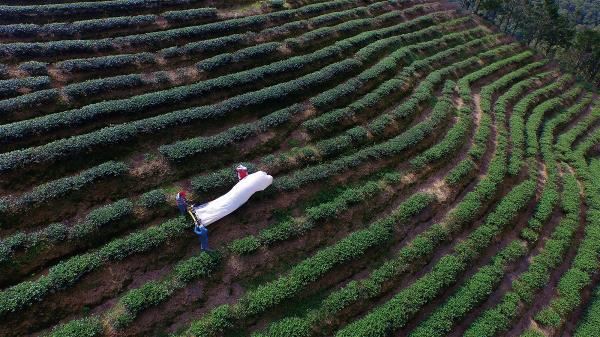
Scottish businessman John Dodd first introduced Taiwanese tea to the West in the late Qing Dynasty. Dodd had established Dodd & Co in Dadaocheng (in the present-day Datong District of Taipei City) in 1865, not long after the Qing government opened the nearby port of Tamsui to international trade. In 1869, he leased two large clipper ships to transport some 128 metric tons of top-grade Taiwanese oolong tea to New York.
Once on their way, the quick and agile clippers easily dodged pirates and made rapid progress across the sea. Dodd’s oolong tea, dubbed “Formosa Oolong tea,” was an instant hit in New York and and became a favorite of the city’s wealthy.
Formosa Oolong was regarded as one of the highest-quality teas from East Asia, and prized by the tea-drinking world.
Unfortunately, this “champagne of teas” was unable to withstand the later onslaught of exports from the world’s larger tea-producing regions. Sales of Formosan tea rapidly declined and the cultured appeal it once held for Western tea drinkers passed into legend.
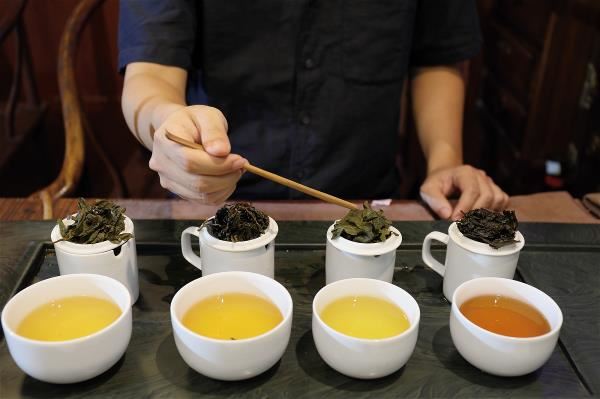
Reintroducing Taiwanese tea
In 2021 Angie Chen, a Taiwanese woman who has lived in Germany for the last seven years, gathered a few other fans of Taiwanese tea and formed the Taiwanese Specialty Tea Society in Europe (TSTSE). The group then signed a memorandum of understanding with the Taiwan Tea Society, aiming to raise the European profile of fine Taiwanese teas by promoting Taiwanese specialty tea culture.
Chen’s own love of tea drinking led directly to her efforts to reintroduce Europeans to Taiwan’s rich and varied teas. Speaking about her method, she explains, “When we looked at wine and coffee connoisseurship, which are popular in the West, we realized that Taiwanese tea culture (and Asian tea more generally) lacked an objective system of evaluation that would help us to educate people about our teas.” Her thinking was that they needed a way to approach Taiwanese tea that made sense to Westerners. “If you live somewhere outside the culture of a tea-producing region, can you develop objective descriptions of tea that make sense to the people there?” says Chen.
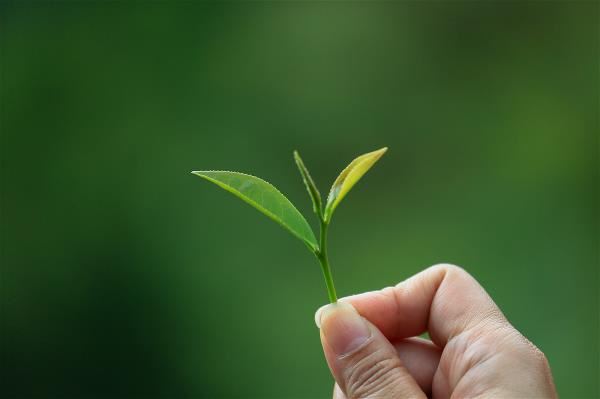
Building a knowledge base
Chen and her group began organizing some of the vast amount of information on tea culture by digitizing and translating documents.
They also built a wiki containing a Taiwanese tea lexicon and compiled a Taiwanese tea dictionary. They are currently working on attaching English translations to common expressions. However, their translation efforts have run into a number of difficulties.
TSTSE’s vice president Chen Hsiao-pu explains: “For example, there are a number of criteria on which competition teas are graded. The problem is that few people outside of Taiwan understand what they mean.”
For instance, within the Taiwanese tea world, the term for a strong retronasal smell is xiangqi chuan bi, meaning something like “a fragrance that penetrates the nose.” “You have to be part of this culture to know what that phrase means.” He smiles as he shares another difficult term, huigan (“returning sweetness”), which he translates as “a sweet aftertaste.”
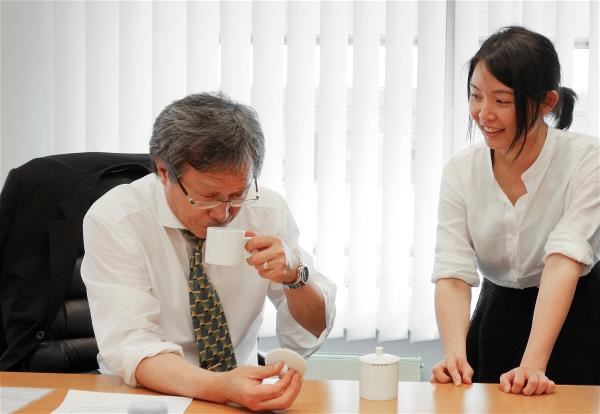
Eastern and Western tastes
The West tends to focus on objective, scientific evaluations, and has comprehensive sensory analysis systems. The East tends to focus more on flavor and finish, and how to enjoy a good tea.
Angie Chen has found the domestic system of evaluating teas to be “too Taiwanese” when promoting our teas internationally, and has therefore switched to using a descriptive terminology that draws on Europeans’ impressions of herbs, and seasonal fruits and vegetables.
Since Germany is famous for its white wines, she has adapted German seasonal and flavor descriptors for those wines to teas. For example, she describes baozhong tea’s flavor by likening it to that of white asparagus harvested in spring.
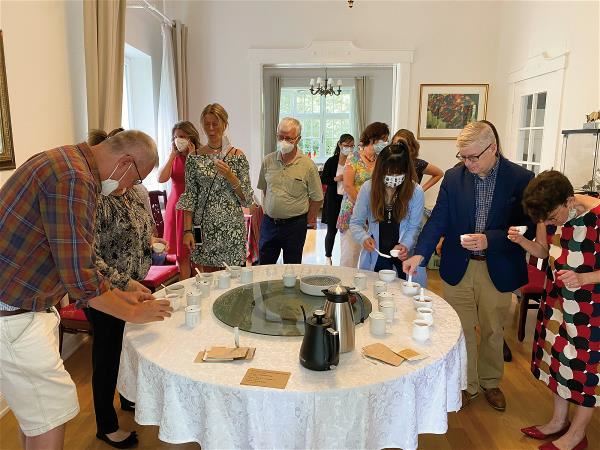
Tailored promotions
Western Europeans enjoy tea, but their tea culture is largely built around tea bags—loose tea is a rarity. On the other hand, Eastern Europeans living behind the Iron Curtain retained a loose-tea culture. These kinds of differences have prompted Angie Chen to further tailor the language she uses to promote tea by region. For example, she focuses on the science of tea when speaking to Germans, and more on cultural refinement and appropriate pastry pairings when talking to the French.
Interestingly, she has also met Polish and Czech experts who can identify Iron Goddess tea (tieguanyin) by its flavor and finish. “When I meet fellow aficionados, I don’t have to explain terminology like xiangqi chuan bi or huigan. We can just sit down and enjoy a pot of tea.”
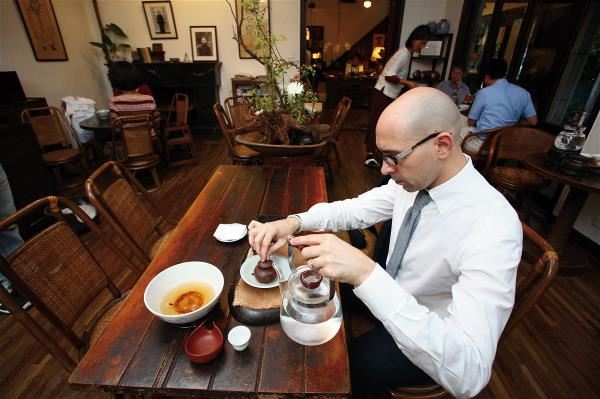
Four hundred years of tea culture
In addition to promoting tea culture, Chen’s group is looking to take part in local arts and culture festivals around Europe. These efforts include applying to the Museum für Kunst und Gewerbe Hamburg (“Hamburg Museum of Arts and Crafts”) to organize a Taiwanese Tea Culture Day, and working with the Berlin Tea Festival and the Hamburg Ministry of Culture and Media to promote a number of programs, as well as helping with the application process for Oriental Beauty tea to receive the European Union’s Protected Geographical Indication (PGI) and Traditional Specialties Guaranteed (TSG) designations.
Chen thinks that Taiwan’s Oriental Beauty tea has a good chance of obtaining the EU designations. The tea originated in a distinct region, the Hsinchu-Miaoli area, and has a unique production process. The latter involves insects known as tea jassids (Jacobiasca formosana) biting the tea leaves, causing the leaves to release terpenes that give the tea a honey- or fruit-like flavor. Obtaining the designations would facilitate the marketing and distribution of Oriental Beauty within the EU, and help raise the international profile of Taiwanese specialty teas in general.
A large part of Angie Chen’s motivation for promoting Taiwanese specialty tea culture has to do with affirming her own identity while living overseas. “We expats want to tell people who we are, what Taiwanese tea is, and what makes it special.”
By promoting Taiwanese specialty teas with her partners and choosing to use tea to tell stories, Chen has dedicated herself to a kind of tea culture mission. “We want to inform people about the 400-year relationship between Taiwanese people, Taiwanese tea and Taiwanese society.” The many elements to the story of Taiwanese tea make the past four centuries “epic and fascinating!”
Article and photos courtesy of Taiwan Panorama October 2021





